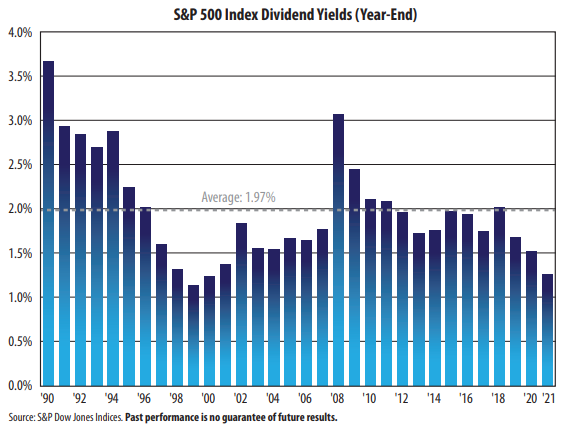
View from the Observation Deck
1. As indicated in the chart above, the 2021 year-end dividend yield of 1.26% on the S&P 500 Index stood well below its long-term average of 1.97% from 1990- 2021.
2. The average dividend yield of 1.97% failed to keep pace with the 2.4% average rate on the Consumer Price Index over that period, according to Bloomberg (See point #9).
3. Yields are up across the board so far in 2022. The dividend yield on the S&P 500 Index increased by 43 basis points (bps) to 1.69% year-to-date (y-t-d) through 11/21/22, which is still below average.
4. Like stock dividend yields, bond yields have increased significantly in 2022. The one category of the bond market that equity investors likely track the most are treasuries, in our opinion. Keep in mind, bonds have a different risk/reward incentive than stocks.
5. The yield on the benchmark 10-year Treasury Note (T-note) increased by 232 bps to 3.83% y-t-d. While up dramatically, it sits below its long-term average of 4.12% from 1990-2021.
6. For comparative purposes, there have only been three times in this millennium (2008, 2011 and 2020) where the yield on the S&P 500 Index exceeded that of the 10-year T-note at year-end, with the most recent being 2020.
7. Historically, the higher bond yields climb, the more competitive they become with traditional stock market returns. With more interest rate hikes expected from the Federal Reserve, there is the potential for bond yields to trend higher.
8. A November survey of 13 equity strategists revealed that the average 2023 year-end price target for the S&P 500 Index was 3,931, essentially unchanged from its 3,949.94 closing price on 11/21/22.
9. For those investors desiring a higher level of income from dividend-paying stocks than what is currently offered by the broader market (S&P 500 Index), there are a plethora of higher-yielding opportunities to consider in the packaged product industry (Mutual Funds, Exchange-Traded Funds, Unit Investment Trusts and Closed-End Funds).



